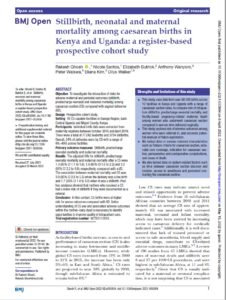
Objective: To investigate the interaction of risks for adverse maternal and perinatal outcomes (stillbirth, predischarge neonatal and maternal mortality) among caesarean section (CS) compared with vaginal deliveries (VD).
Setting: 10 CS-capable facilities in Busoga Region, East-Central Uganda and Migori County, Kenya.
Participants: Individual birth data were extracted from maternity registers between October 2016 and April 2019. There were a total of 77 242 livebirths and 3734 stillbirths. Overall, 24% of deliveries were by CS with a range of 9%-49% across facilities.
Strengths and Limitations of This Study
- This study uses data from over 80 000 births across 10 facilities in Kenya and Uganda with a range of caesarean section rates, to compare risk of intrapartum stillbirths, predischarge neonatal mortality, and facility-based pregnancy-related maternal death among women who underwent caesarean section compared to women who delivered vaginally.
- This study explores risk of adverse outcomes among women who were referred in, and uncovers potential avenues of future exploration.
- We lacked data on various maternal characteristics such as Robson criteria for caesarean section, antenatal care coverage, indication for caesarean section, perioperative and postoperative complications, and cause of death.
- We also lacked data on system-related factors such as time between caesarean section decision and incision, access to anesthesia and personnel conducting the caesarean section.